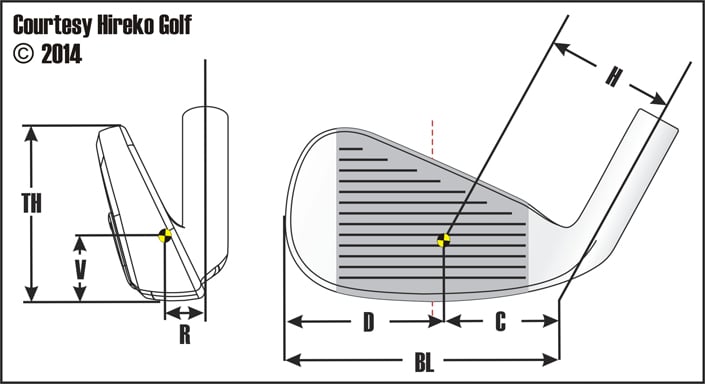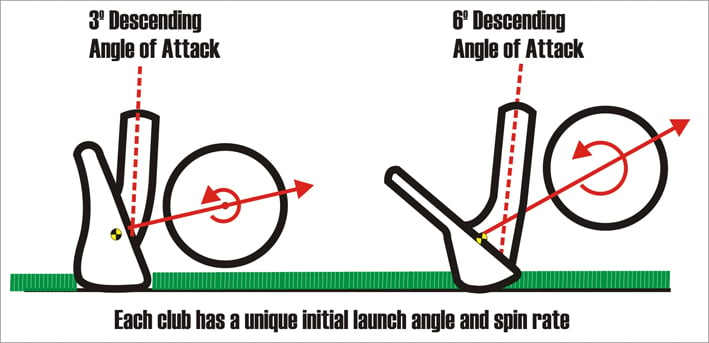Why Aren’t Golf Club Lofts in Nice 4 Degree Increments?
There are a number of parameters (some equipment and other swing related) that influence how far you hit the golf ball. It is a must having the right combinations of lofts in the set to having nice incremental yardage gaps between each club.
One question I get occasionally from customers is why don’t the lofts of irons and wedges increase at the rate of 4 degrees per club in order to have consistent distance gaps? After all, it is only fair to think if the lofts are separated like that then the distances should be spread out consistently as well. However, what may make perfect sense on paper doesn’t work out the same in reality as we will explain in this article.
Golf Club Lofts (1950-1970)
At one time loft were sold with nice even 4 degree gaps per iron. This occurred most recently from 1950-1970. Here is what the typical lofts were of that age.
| Club | Loft |
| 2 iron | 20 |
| 3 iron | 24 |
| 4 iron | 28 |
| 5 iron | 32 |
| 6 iron | 36 |
| 7 iron | 40 |
| 8 iron | 44 |
| 9 iron | 48 |
| PW | 52 |
| SW | 56 |
Modern Golf Club Lofts
Soon after that we started to see more of the separation as they are today with lower lofted irons gapped closer to 3º apart and the wedges and perhaps the 9 iron at 5º separation. Today, the lofts look closer to the following, athough you may see iron lofts even stronger than this on sets made in the 2020's.
| Club | Loft |
| 3 iron | 20 |
| 4 iron | 23 |
| 5 iron | 26 |
| 6 iron | 29 |
| 7 iron | 33 |
| 8 iron | 37 |
| 9 iron | 41 |
| PW | 45 |
| GW | 50 |
| SW | 55 |
| LW | 60 |
There is a rhyme and reason why manufacturers produce lofts like this. Some may say this is simply due to the lofts have strengthened to give you more distance and they couldn’t continue the progression in the lower numbered clubs and make them playable. While there may be some truth to that, it is more of a function of the dynamics of the swing.
Center of gravity of the head
Each head has a unique set of CG coordinates. This is a function of many parameters such as the hosel length, blade length, toe height, sole width, hosel offset, face thickness, etc. Not only does the CG coordinates changed from model to model, but each club throughout the set. You may wonder why each club is in the set is a different length. That has to do with the weight being different on each head (except single length irons). Where the addition of weight is placed establishes the CG location. You may find that as the loft increases, the CG is shifting higher vertically as well as further behind the axis of the shaft. Yet at the end, the manufacturer ties all this together to make a playable set.

After years and years of manufacturing and player product testing, loft specifications are set appropriately, especially with the advent of sophisticated launch monitors where distances can be pin pointed exactly. However, there are a few other considerations to why lofts don’t always follow in a nice, neat orderly fashion.
Golfer's Angle of Attack
The loft the head was designed and what the loft at impact can be entirely different. For example, we are generally taught with long irons to have more of a shallow swing and with higher lofted clubs to hit more down on the ball. What we are talking about is angle of attack. This varies per person and per club (not to mention swing-to-swing). The club on the left in the diagram is a 5-iron with a loft of 26º, but the player has angle of attack of 3 degrees leaving the face plane with 22º loft at impact. On the right is a 56º sand wedge with the player hitting down at a 6º angle leaving the face plane at 50º. Whenever the player changes their angle of attack and/or impact position on the face, the ball will come off at a different launch angle and spin rate and that is why we experience distance variations with the same club.
Shaft Flex
The stiffness of irons and wedges, the vast majority of the time, increases in frequency (cpm) as they reduce in length. For steel shafts it is roughly 4-5 cpm per ½” and with graphite shafts can be less depending upon the trimming instructions. Guess what? The stiffness of the shaft influences the dynamic loft at impact. If you have a more flexible shaft, that helps bow the shaft forward increasing the loft and subsequently altering the trajectory, spin and distance of the ball.
The Low Down on Loft Progression in the Set
As you can see that there are a number of parameters (some equipment and other swing related) that influence how far you hit the ball. Having the right combinations of lofts in the set in order to have nice incremental gaps between each club is a must. You’ll often find that the lofts will not always follow the same orderly progression your distances do. If you have problems with gapping, seek a professional club fitter. Often times they can adjust the lofts of your irons and wedges accordingly.
